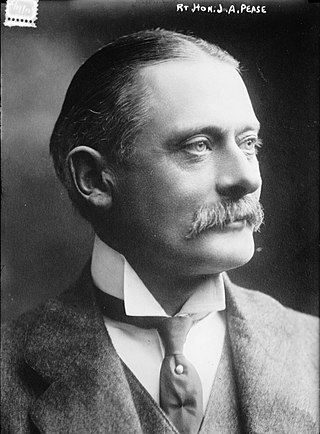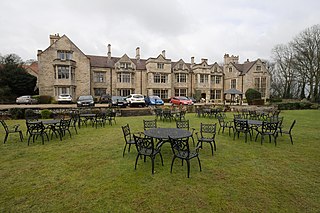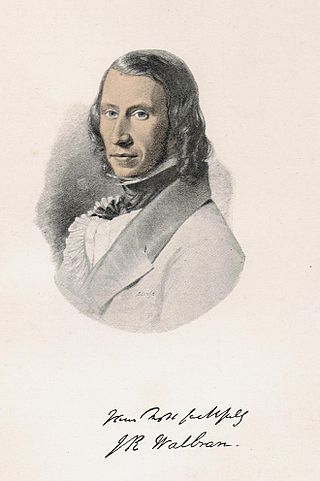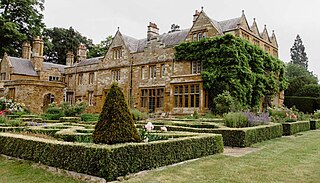
Headlam Hall is a 17th-century country house at The Green, Headlam, near Gainford, County Durham, England. It is a Grade II* listed building [1] now in use as a hotel and country club.

Headlam Hall is a 17th-century country house at The Green, Headlam, near Gainford, County Durham, England. It is a Grade II* listed building [1] now in use as a hotel and country club.

Henry Birkbeck (1564-1637) built Headlam Hall around the time of his marriage in 1606 to Anne Brackenbury. He was the son of Thomas Birkbeck a wealthy landowner. As a present for his wife he had an elaborate oak fireplace installed in the main hall with the Birkbeck coat of arms displayed in the centre of the mantle. This feature still stands today. [2] It was described in several early history books. John Richard Walbran in 1846 says it was a richly ornamented fireplace in the centre compartment of which “is a mantled shield, hearing a fess gobony, between three lions heads erased, a crescent for difference ; impaling three chevronels interlaced — the arms of Henry Birkbeck, Esq.” [3]
When Henry died in 1637 his only child Eleanor inherited the Hall. She married Henry Draper (1611-1666) and together they lived at the house. Henry was a personal friend of George Fox the founder of the Quaker religion and it is recorded that he was a guest at Headlam Hall on several occasions. [4]

When Henry Draper died in 1666 his son John Draper became the owner. However he died five years later and as he had no living heirs his sister Anne and her husband Thomas Mossock (died 1710). When he died their son Thomas Mossock who died in 1721 became the owner. As he had no heirs his sister Ann and her husband Ralph Clark inherited the Hall. There is a memorial plaque in Gainford Church in their honour. [5] When he died in 1736 their only surviving child Ann Clark who had married Lawrence Brockett inherited the house.
Lawrence Brockett (1694-1750) was an attorney and is credited with making substantial alterations and additions to the house. When he died in 1750 his eldest son Henry inherited the property. He advertised it for sale but it was not sold. He died two years later in 1752 so it was then left to his younger brother the noted historian Lawrence Brockett (1724-1768).

Lawrence Brockett (1724-1768) went to Trinity College at the University of Cambridge in 1743 and was appointed the Professor of Modern History in 1762. [6] He did not marry but had an illegitimate son William Neville Brockett (1861-1840). [7] In his Will he recognised this child who was then only seven and left Headlam Hall to him. [8]
From about 1800 William rented the house to various tenants. From 1804 until 1831 it was a boys' school called Chapmans Academy. The headmaster was John Chapman of Alwent Hall. [9] He died in 1840 and in 1845 the Brockett family sold the house to John Hett. [10] It remained in the Hett family for the next sixty years.
John Hett (1777-1853) was born in 1777 in Billingham, Durham. In 1833 he married Mary Ann Huson (1801-1857). The couple had two sons and a daughter. He died in 1853 and his wife Mary Ann continued to live at Headlam Hall with their eldest son John Hett (1839-1899). There is a gravestone in St Marys Churchyard, Gainford as a memorial to both of them. [11]

After Mary Ann’s death their son John Hett (1839-1899) lived at Headlam hall for some time. In 1860 he married Emma Elizabeth Cundell (1830-1902) and the couple had two sons and four daughters. He was a wealthy landowner. John died in 1899 and Emma in 1902. There is a gravestone next to John’s parents in Gainford churchyard in their honour. [12] After John’s death their son Richard Percy Hett moved into the Hall. [13] Several years later he sold it to Joseph Albert Pease. A newspaper reported in 1904 that he was in residence at Headlam Hall at this date. [14]
Sir Joseph Albert (Jack) Pease, 1st Baron Gainford was born in 1860. His father was Sir Joseph Whitwell Pease, prominent industrialist and banker. Jack Pease, as he was known, enjoyed an early life of wealth and privilege in one of Britain's most prominent family dynasties. He was educated at the University of Cambridge where he shone as secretary of the amateur dramatic club, was master of the university drag hounds, and represented the university at polo and rugby. He also captained the Trinity College cricket eleven. [15] He became a politician and was a personal friend of Asquith.
In 1886 he married Ethel (Elsie) Havelock-Allen, the daughter of Sir Henry Marshman Havelock-Allen. The couple had a son and two daughters. His wife was a notable socialite and held numerous functions at the Hall. Jack died in 1943 and the house was sold to Sir John Blunt. [16] Sir John Lionel Reginald Blunt 10th Baronet (1908-1969) [17] lived at Headlam Hall for the next four years until his second marriage in 1947. It was then sold to Lieutenant Colonel Hugh Morton Stobart, C.B.E., D.S.O.
Lieutenant Colonel Hugh Morton Stobart was a wealthy industrialist who died in 1952. He left the house to his wife Rosalie Mary Stobart (who in 1960 married Major Seed) [18] and his children. In 1977 it was sold to the Robinson family who still own it today.
Baron Gainford, of Headlam in the County Palatine of Durham, is a title in the Peerage of the United Kingdom. It was created on 3 January 1917 for the Liberal politician Jack Pease, a member of the Darlington Pease family. He notably served as President of the Board of Education from 1911 to 1915. Pease was the second son of Sir Joseph Pease, 1st Baronet, and the grandson of Joseph Pease, while Arthur Pease was his uncle and Sir Arthur Pease, 1st Baronet, Beaumont Pease, 1st Baron Wardington, and Herbert Pease, 1st Baron Daryngton, were his first cousins. The third baron was a former member of the London County Council and of the Greater London Council. As of 2013 the title is held by his younger brother, the fourth baron, an architect and town planner; County Planning Officer for Ross and Cromarty 1967–1975 and Scottish Office Inquiry Reporter 1978–1993.

Joseph Albert Pease, 1st Baron Gainford, known as Jack Pease, was a British businessman and Liberal politician. He was a member of H. H. Asquith's Liberal cabinet between 1910 and 1916 and also served as Chairman of the BBC between 1922 and 1926.

Sir Joseph Whitwell Pease, 1st Baronet was a British Liberal Party politician who sat in the House of Commons from 1865 to 1903.
Joseph Pease, 2nd Baron Gainford (1889–1971) was a British hereditary peer and member of the Pease family.
The Pease family is an English and mostly Quaker family associated with Darlington, County Durham, and North Yorkshire, descended from Edward Pease of Darlington (1711–1785).

There have been two baronetcies created for members of the Pease family, both in the Baronetage of the United Kingdom. Both titles are extant.

Close House is a country estate near Heddon-on-the-Wall, Northumberland. The estate contains a Grade II* listed former mansion house, which is currently a private residence, and Close House Golf Club.

Redworth Hall is a 17th-century country house at Redworth, Heighington, County Durham, England now converted to a hotel. It is a listed building.

Middleton Lodge is a Georgian Palladian mansion set within 200 acres (0.81 km2) of open countryside, on the outskirts of the village of Middleton Tyas, a mile or so off the A1 near Scotch Corner and a 15-minute drive from Darlington, County Durham.

Grantley Hall is a Country house located in North Yorkshire, England. It is situated near Grantley, about 5 miles (8 km) to the west of Ripon, on the banks of the River Skell. It is listed Grade II* on the National Heritage List for England, and the Japanese garden at the hall is listed Grade II on the Register of Historic Parks and Gardens.

Gainford Hall is a privately owned Jacobean manor house at Gainford, County Durham. It is a Grade I listed building but as of 2014 is registered as a Building at Risk.

John Richard Walbran was a British antiquarian.
Lawrence Brockett was an English academic.

Narborough Hall is a Grade II* listed building in Narborough in Leicestershire. Believed to date from 1596 this Elizabethan manor house was built by James Meade, a local landowner. However it wasn’t until it was extensively remodelled in the mid-19th century that it became known as Narborough Hall. It is notable because of its construction from local pink granite.

Soughton Hall is a Grade II* listed country house hotel in Sychdyn, Flintshire, Wales. Notable guests that have stayed include Luciano Pavarotti, Michael Jackson and King Juan Carlos I of Spain. William John Bankes inherited Soughton Hall in the 1815.

Greenham Hall is a country house at Wellington in Somerset. It was once the home of Admiral of the Fleet Sir John Kelly. It is a Grade II listed building.

Hardwick Hall in Sedgefield, County Durham is a building of historical significance and is listed on the English Heritage Register. A major part of it was built in the late 1700s but it is possible that some of it dates from about 1634. It was the residence for many notable people for two centuries. It is now a hotel which provides accommodation and restaurant services and caters for special events particularly weddings.

Sandywell Park is an Jacobean Georgian manor house, five miles east of Cheltenham in Gloucestershire, England. Built in 1704 by Henry Brett, it was extended a few times over the 18th century. In the mid-eighteenth century the Sandywell Park estate acquired the Whittington Court building. Sandywell Park is today a Grade II listed building.

Malling House is a 17th-century country house in Lewes, East Sussex, England. It is a Grade I listed building and serves as the headquarters of Sussex Police.

Flore House in Flore, Northamptonshire, is a country house of historical significance and is Grade II listed on the English Heritage Register. It was built in 1608 for the Enyon family and was the residence of notable people over the next four centuries. Today it provides guest accommodation and caters for special events including weddings.